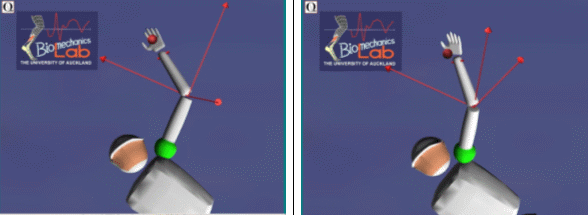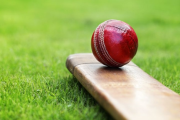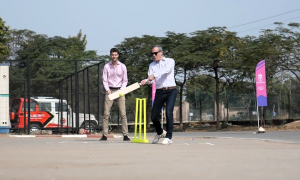With confusion still surrounding around ICC rule for illegal bowling action, the ambitious inertial sensors project seems bit too optimistic to me.
Before we begin, you need to know the meaning/definition for some of the terms.
1) Inertia in simple terms is a mass, which resist change in its motion or acceleration. In Physics, the tendency of a body at rest to remain at rest or of a body in straight line motion to stay in motion in a straight line unless acted on by an outside force (remember Newton’s first law of motion?) is called inertia.
2) Inertial Sensors work completely on this basis of inertia. They are used to detect whether an object changed in its velocity of motion or angle from the defined limitations. The timely deployment of air bag in cars just before the crash or during the side roll over of cars are the best example to understand how inertial sensors works (read its working in automobiles here).
3) Acceleration sensors senses the movement of an object from one point to another along a straight line or axis.
4) Rotation sensing measures the angular rate, i.e. how quickly an object turns. The rotation is typically measured in degrees per second of change.
5) Multiple degree of freedom sensing relies on the combined input of multiple sensing types, such as acceleration and rotation, along multiple axis
6) Legal Delivery – According to the Laws of Cricket (law 24.3), A ball is fairly delivered in respect of the arm if, once the bowler’s arm has reached the level of the shoulder in the delivery swing, the elbow joint is not straightened partially or completely from that point until the ball has left the hand. This definition shall not debar a bowler from flexing or rotating the wrist in the delivery swing. Allowed level of elbow extension threshold tolerance is 15 degree for all bowlers.
Note: Whatever i am saying here is entirely based on my level of knowledge and predictions, not the real working module being used by MCC (Marylebone Cricket Club) or ICC (International Cricket Council). Just assume, i am someone sitting next to you and telling what i know.
As announced by ICC, bowlers will wear an equipment in which inertial sensors are incorporated to detect the illegal bowling action, the moment bowler delivers the ball during the play (match and training sessions). So the system that processes the received data through sensors have to record the data, decode the analog signals into angles (data), cross-check with already defined set of values and evaluate whether the data falls in legal or illegal category very quickly, so that result will be delivered in near real time to umpires or match referees. Inertial sensors typical data includes position, orientation and velocity of a moving object. Remember, Inertial sensors are already being used in other sports like athletics to observing the running and stride characteristics.

Animated Images from Dr Rene, E. D. Ferdinands, Uwe Kersting bowling and throwing action analysis paper, demonstrating the “jerking” or “throwing” bowling action characteristics.
To judge whether the bowler action is legal action or not, ICC depends on their elbow extension. Inertial sensors measures and gives the angles of the bowlers elbow extension from the time their arm reaches the height of shoulder in delivery swing till the completion of their bowling action (just before the follow through). As you can see in the figure above, throwing (or chucking) type bowlers actions starts with more bend in elbow and gradually straightens in time for the release of the ball from hand during the delivery swing.
Gyroscopes (rotational sensor) can be used to measure the varying angular rate of elbow whereas Accelerometers (motion sensor) can measure the velocity of object (elbow) axis in the inertial sensors system. First, the initial position and velocity of bowling arm elbow will be measured when it reaches the shoulder height. Then depending on the changes elbow/arm position, orientation and velocity undergoes from the shoulder height, the action will be deemed legal or not.
Accelerometer is mass-spring system, which when accelerated beyond the threshold value set (i.e. when bowler arm sees rapid acceleration in speed and direction of the elbow), results in displacement. Gyroscopes is an oscillator, which when rotated generates a perpendicular Coriolis force on the mass (cricket ball), where larger the force further the mass is away from the center (elbow) of rotation. Then the actual rotation of angle is measured from the different read-outs on either side of oscillator. Multiple degree of freedom sensing will form the core of inertial sensor system to be used by MCC i think, because it combines both accelerometer and gyroscopes sensors. Also tilt sensing (angle of change), shock sensing (impact with respect to predetermined level) and vibration sensing (acceleration and deceleration occurred in a period of time) will be used to increase the accuracy in determining illegal bowling action.
I presented my idea on how the ongoing MCC project module design will look and work. Inertial sensors are very vast subject, hard for someone like me who just graduated to master everything. My knowledge on these is very much limited to theory rather than practical. I read about these for first time a year ago when i am looking for my final semester project. It interested me at very first read itself but i don’t have good knowledge in electrical and embedded (hardware) engineering being a software engineer, so i can’t proceed further with my interest.
Can it detect illegal bowling actions accurately?
Nothing is impossible and inertial sensors are very much capable in detecting it. But my worries are with real definition of illegal bowling action. ICC code for illegal bowling action is still under severe criticism despite undergoing several changes (acceptable elbow extension angle for bowlers increased from 0 to 15 degrees) over the last two decades. Biometric analysis which so far been used by ICC to prove whether a bowler action illegal or not, is also not accurate enough, apart from the argument that bowlers knowing they are under radar will not bowl like they do in match conditions. Though that’s why ICC is moving towards inertial sensors, the accuracy still depends on the threshold value set to differentiate the legal and illegal bowling action. Read Dr Rene E, D. Ferdinand, and Uwe Kersting papers here and here to understand how difficult to judge a bowler is throwing or not, because they exhibit varying angles in varying times.
I am a firm believer that cricket will be at his best when it uses technology in minimum (like action replays). But if you want technology to take over the game (like DRS system doing) and think it will erase all errors, then you are doomed. Because I believe game of cricket is an ambiguous and circumstantial in nature. The first rule for any reliable software project is to have unambiguous constraints.
Unless MCC comes up with definite definition for illegal bowling action considering all the different cases (Lasith Malinga, Johan Botha, Saeed Ajmal and more players), accuracy of the project will not be 100%, atleast in the eyes of cricket fanatics and expert.
Tags: accelerating sensing, Accelerometers, bio metric analysis on ilegal bowling action, bowlers action legality are endless debate in cricket, bowlers actions are questionable, bowlers are allowed to extend elbow till 15 degree, Brett Lee, Cricket, doosra, Fidel Edwards, Gyroscopes, Harbhajan, ICC going to use inertial sensors to detect illegal bowling action, ICC rules of legal bowling action, Inertial Sensors, Inertial sensors in cricket, Johan Botha, Lasith Malinga, Laws of cricket, Marlon Samuels, MCC doing a project based on inertial senors, Mitchell Johnson, Muttaih Muralitharan, Rotational sensing, Saeed Ajmal, sensors, Shoaib Akthar, Sports, throwing or chucking in cricket











